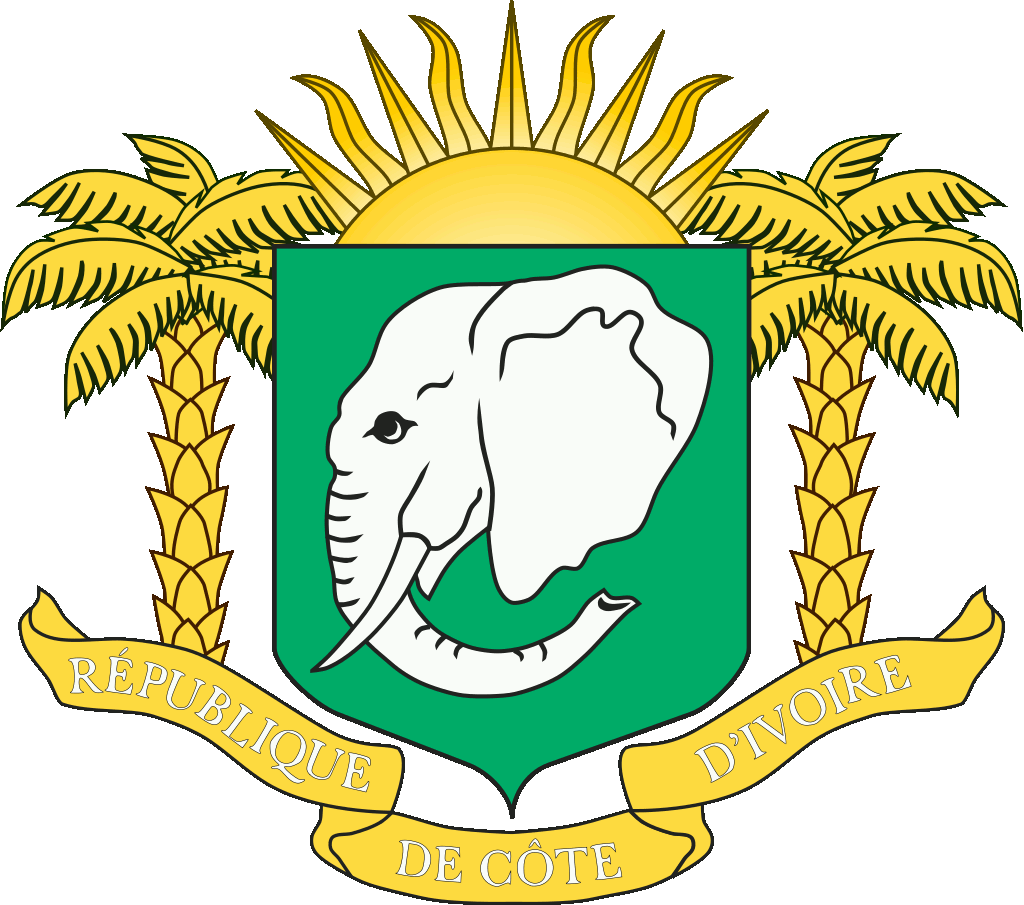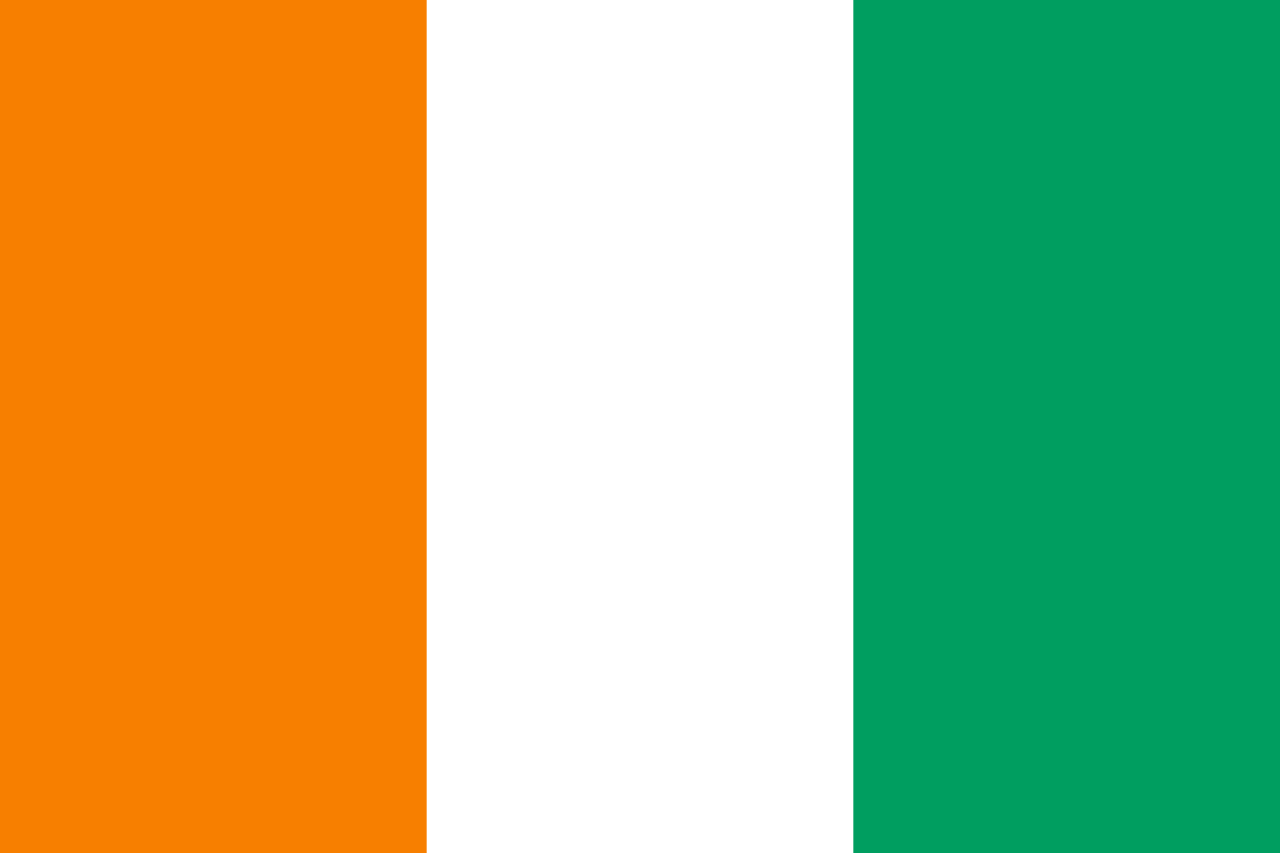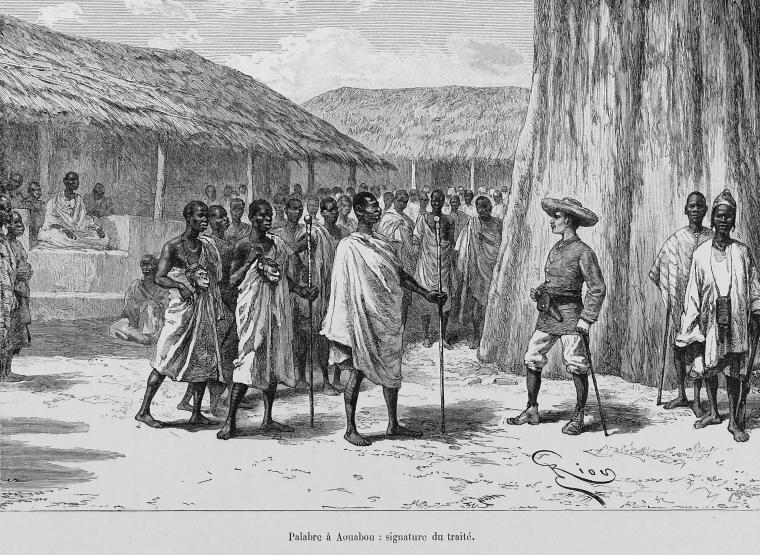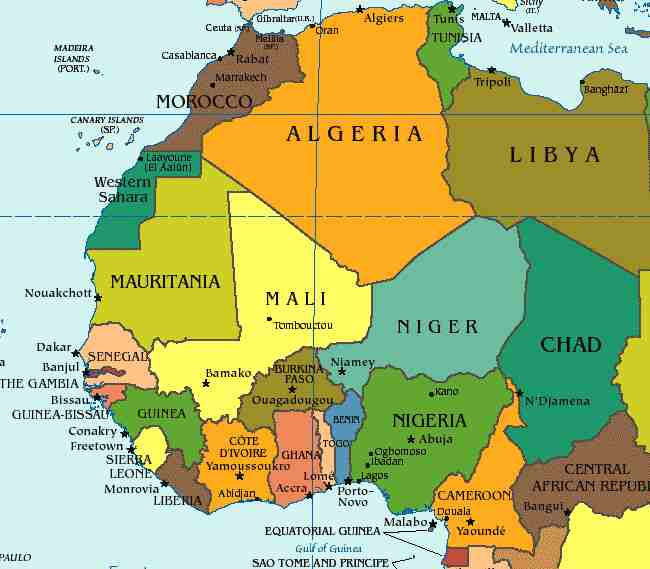|

Ivory Coast is a country in western sub-Saharan Africa. It borders Liberia and Guinea in the west, Mali and Burkina Faso in the north, Ghana in the east, and the Gulf of Guinea (Atlantic Ocean) in the south. The country lies between latitudes 4° and 11°N, and longitudes 2° and 9°W. Around 64.8% of the land is agricultural land; arable land amounted to 9.1%, permanent pasture 41.5%, and permanent crops 14.2%. Water pollution is one of the biggest issues that the country is currently facing.
Coast, also known as Côte d'Ivoire and officially the Republic of Côte d'Ivoire, is a country on the southern coast of
West Africa. Its capital city of Yamoussoukro is located in the centre of the country, while its largest city and economic centre is the port city of Abidjan. It borders Guinea to the northwest, Liberia to the west, Mali to the northwest, Burkina Faso to the northeast, Ghana to the east, and the Gulf of Guinea
(Atlantic
Ocean) to the south. With 30.9 million inhabitants in 2023, Ivory Coast is the third-most populous country in West
Africa. Its official language is French, and indigenous languages are also widely used, including Bété, Baoulé, Dioula, Dan, Anyin, and Cebaara Senufo. In total, there are around 78 different languages spoken in Ivory Coast. The country has a religiously diverse population, including numerous followers of Islam, Christianity, and traditional faiths like Animism.
Before its colonization, Ivory Coast was home to several states, including Gyaaman, the Kong Empire, and Baoulé. The area became a protectorate of France in 1843 and was consolidated as a French colony in 1893 amid the Scramble for Africa. It achieved independence in 1960, led by Félix Houphouët-Boigny, who ruled the country until 1993. Relatively stable by regional standards, Ivory Coast established close political-economic ties with its West African neighbours while maintaining close relations with the West, especially France. Its stability was diminished by a coup d'état in 1999 and two civil wars—first between 2002 and 2007 and again during 2010–2011. It adopted a new constitution in 2016.
Ivory Coast is a republic with strong executive power vested in its president. Through the production of coffee and cocoa, it was an economic powerhouse in West Africa during the 1960s and 1970s, then experienced an economic crisis in the 1980s, contributing to a period of political and social turmoil that extended until 2011. Ivory Coast has experienced again high economic growth since the return of peace and political stability in 2011. From 2012 to 2023, the economy grew by an average of 7.1% per year in real terms, the second-fastest rate of economic growth in Africa and fourth-fastest rate in the world. In 2023, Ivory Coast had the second-highest GDP per capita in West Africa, behind Cape Verde. Despite this, as of the most recent survey in 2016, 46.1% of the population continues to be affected by multidimensional poverty. In 2020, Ivory Coast was the world's largest exporter of cocoa beans and had high levels of income for its region. The economy still relies heavily on
agriculture, with smallholder cash-crop production predominating.
Ivory Coast has, for the region, a relatively high income per capita (US$1,662 in 2017) and plays a key role in transit trade for neighbouring landlocked countries. As of the most recent survey in 2016, 46.1% of the
population continues to be affected by multidimensional
poverty. The country is the largest economy in the West African Economic and Monetary Union, constituting 40% of the monetary union's total GDP. Ivory Coast is the fourth-largest exporter of general goods in sub-Saharan Africa (following South Africa, Nigeria, and Angola).
The country is the world's largest exporter of cocoa beans. In 2009, cocoa-bean farmers earned $2.53 billion for cocoa exports and were projected to produce 630,000 metric tons in 2013. Ivory Coast also has 100,000
rubber farmers who earned a total of $105 million in 2012.
Close ties to France since independence in 1960, diversification of agricultural exports, and encouragement of foreign investment have been factors in economic growth. In recent years, Ivory Coast has been subject to greater competition and falling prices in the global marketplace for its primary crops of coffee and cocoa. That, compounded with high internal corruption, makes life difficult for the grower, those exporting into foreign markets, and the labour force; instances of indentured labour have been reported in the country's cocoa and coffee production in every edition of the U.S. Department of Labor's List of Goods Produced by Child Labor or Forced Labor since 2009.
Ivory Coast's economy has grown faster than that of most other African countries since independence. One possible reason for this might be taxes on exported agriculture. Ivory Coast, Nigeria, and Kenya were exceptions as their rulers were themselves large cash-crop producers, and the newly independent countries desisted from imposing penal rates of taxation on exported agriculture. As such, their economies did well.
Around 7.5 million people made up the workforce in 2009. The workforce took a hit, especially in the private sector, during the early 2000s with numerous economic crises since 1999. Furthermore, these crises caused companies to close and move locations, especially in the tourism industry, and transit and banking companies. Decreasing job markets posed a huge issue as unemployment rates grew.
Unemployment rates rose to 9.4% in
2012. Solutions proposed to decrease unemployment included diversifying jobs in small trade. This division of work encouraged farmers and the agricultural sector. Self-employment policy, established by the Ivorian government, allowed for very strong growth in the field with an increase of 142% in seven years from 1995.

BIODIVERSITY
There are over 1,200 animal species including 223 mammals, 702 birds, 161 reptiles, 85 amphibians, and 111 species of fish, alongside 4,700 plant species. It is the most biodiverse country in West Africa, with the majority of its wildlife population living in the nation's rugged interior. The nation has nine national parks, the largest of which is Assgny National Park which occupies an area of around 17,000 hectares or 42,000 acres.
The country contains six terrestrial ecoregions: Eastern Guinean forests, Guinean montane forests, Western Guinean lowland forests, Guinean forest–savanna mosaic, West Sudanian savanna, and Guinean mangroves. It had a 2018 Forest Landscape Integrity Index mean score of 3.64/10, ranking it 143rd globally out of 172 countries.
FRENCH RULE AND SLAVE TRADING
Compared to neighbouring Ghana, Ivory Coast, though practising slavery and slave raiding, suffered little from the
slave
trade. European slave and merchant ships preferred other areas along the coast. The earliest recorded European voyage to West Africa was made by the Portuguese in 1482. The first West African French settlement, Saint-Louis, was founded in the mid-17th century in Senegal, while at about the same time, the Dutch ceded to the French a settlement at Gorée Island, off Dakar. A French mission was established in 1687 at Assinie near the border with the
Gold Coast (now Ghana). The Europeans suppressed the local practice of slavery at this time and forbade the trade to their merchants.
Assinie's survival was precarious, however; the French were not firmly established in Ivory Coast until the mid-19th century. In 1843–44, French Admiral Louis Édouard Bouët-Willaumez signed treaties with the kings of the Grand-Bassam and Assinie regions, making their territories a French protectorate. French explorers, missionaries, trading companies, and soldiers gradually extended the area under French control inland from the lagoon region. Pacification was not accomplished until 1915.
Activity along the coast stimulated European interest in the interior, especially along the two great rivers, the Senegal and the Niger. Concerted French exploration of West Africa began in the mid-19th century but moved slowly, based more on individual initiative than on government policy. In the 1840s, the French concluded a series of treaties with local West African chiefs that enabled the French to build fortified posts along the Gulf of Guinea to serve as permanent trading centres. The first posts in Ivory Coast included one at Assinie and another at Grand-Bassam, which became the colony's first capital. The treaties provided for French sovereignty within the posts and for trading privileges in exchange for fees or coutumes paid annually to the local chiefs for the use of the land. The arrangement was not entirely satisfactory to the French, because trade was limited and misunderstandings over treaty obligations often arose. Nevertheless, the French government maintained the treaties, hoping to expand trade. France also wanted to maintain a presence in the region to stem the increasing influence of the British along the Gulf of Guinea coast.
FRENCH COLONIAL ERA
By the end of the 1880s, France had established control over the coastal regions, and in 1889 Britain recognized French sovereignty in the area. That same year, France named Treich-Laplène the titular governor of the territory. In 1893, Ivory Coast became a French colony, with its capital in Grand-Bassam, and Captain Binger was appointed governor. Agreements with Liberia in 1892 and with Britain in 1893 determined the eastern and western boundaries of the colony, but the northern boundary was not fixed until 1947 because of efforts by the French government to attach parts of Upper Volta (present-day Burkina Faso) and French Sudan (present-day Mali) to Ivory Coast for economic and administrative reasons.
France's main goal was to stimulate the production of exports. Coffee, cocoa, and palm oil crops were soon planted along the coast. Ivory Coast stood out as the only West African country with a sizeable population of European settlers; elsewhere in West and Central Africa, Europeans who emigrated to the colonies were largely bureaucrats. As a result, French citizens owned one-third of the
cocoa, coffee, and banana plantations and adopted the local forced-labour system.
Throughout the early years of French rule, French military contingents were sent inland to establish new posts. The African population resisted French penetration and settlement, even in areas where treaties of protection had been in force. Among those offering the greatest resistance was Samori Ture, who in the 1880s and 1890s was establishing the Wassoulou Empire, which extended over large parts of present-day Guinea, Mali, Burkina Faso, and Ivory Coast. Ture's large, well-equipped army, which could manufacture and repair its own firearms, attracted strong support throughout the region. The French responded to Ture's expansion and conquest with military pressure. French campaigns against Ture, which were met with fierce resistance, intensified in the mid-1890s until he was captured in 1898 and his empire dissolved.
France's imposition of a head tax in 1900 to support the colony's public works program provoked protests. Many Ivorians saw the tax as a violation of the protectorate treaties because they felt that France was demanding the equivalent of a coutume from the local kings, rather than the reverse. Many, especially in the interior, also considered the tax a humiliating symbol of submission. In 1905, the French officially abolished slavery in most of French West Africa. From 1904 to 1958, Ivory Coast was part of the Federation of French West Africa. It was a colony and an overseas territory under the Third Republic. In
World War I, France organized regiments from Ivory Coast to fight in France, and colony resources were rationed from 1917 to 1919. Until the period following World War II, governmental affairs in French West Africa were administered from Paris. France's policy in West Africa was reflected mainly in its philosophy of "association", meaning that all Africans in Ivory Coast were officially French "subjects" but without rights to representation in Africa or France.
Until 1958, governors appointed in Paris administered the colony of Ivory Coast, using a system of direct, centralized administration that left little room for Ivorian participation in policy-making. The French colonial administration also adopted divide-and-rule policies, applying ideas of assimilation only to the educated elite. The French were also interested in ensuring that the small but influential Ivorian elite was sufficiently satisfied with the status quo to refrain from developing anti-French sentiments and calls for independence. Although strongly opposed to the practices of association, educated Ivorians believed that they would achieve equality in the French colonial system through assimilation rather than through complete independence from France. After the assimilation doctrine was implemented through the postwar reforms, though, Ivorian leaders realized that even assimilation implied the superiority of the French over the Ivorians and that discrimination and inequality would end only with independence.

INDEPENDENCE
Félix Houphouët-Boigny, the son of a Baoulé chief, became Ivory Coast's father of independence. In 1944, he formed the country's first agricultural trade union for African cocoa farmers like himself. Angered that colonial policy favoured French plantation owners, the union members united to recruit migrant workers for their own farms. Houphouët-Boigny soon rose to prominence and was elected to the French Parliament in Paris within a year. A year later, the French abolished forced labour. Houphouët-Boigny established a strong relationship with the French government, expressing a belief that Ivory Coast would benefit from the relationship, which it did for many years. France appointed him as a minister, the first African to become a minister in a European government.
A turning point in relations with France was reached with the 1956 Overseas Reform Act (Loi Cadre), which transferred several powers from Paris to elected territorial governments in French West Africa and also removed the remaining voting inequities. On 4 December 1958, Ivory Coast became an autonomous member of the French Community, which had replaced the French Union.
By 1960, the country was easily French West Africa's most prosperous, contributing over 40% of the region's total exports. When Houphouët-Boigny became the first president, his government gave farmers good prices for their products to further stimulate production, which was further boosted by a significant immigration of workers from surrounding countries. Coffee production increased significantly, catapulting Ivory Coast into third place in world output, behind Brazil and Colombia. By 1979, the country was the world's leading producer of cocoa. It also became Africa's leading exporter of pineapples and palm oil. French technicians contributed to the "Ivorian miracle". In other African nations, the people drove out the Europeans following independence, but in Ivory Coast, they poured in. The French community grew from only 30,000 before independence to 60,000 in 1980, most of them teachers, managers, and advisors. For 20 years, the economy maintained an annual growth rate of nearly 10%—the highest of Africa's non-oil-exporting countries.

Map
of West Africa
External
links
500ml
PET bottle
|
Adelaide
Aden
- Yemen
Afghanistan
Africa
Alaska
Albania
Algeria
Amazon
Rainforest
Amsterdam
Antarctic
Arctic
North Pole
Argentina
Asia
Athens
Atlantis
- Plato's Lost City
Australia
Austria
Aztecs
- Mexico
Baghdad
Bahamas
Bahrain
Bangladesh
Barbados
Beachy
Head, England
Belgium
Benin
Berlin
Bermuda
Black
Rock Desert
Bohemia
Bolivia Bonneville
Utah History
Bonneville,
Utah, USA
Brazil
Brighton
- West Pier
British
Columbia
Buckingham
Palace
Bulgaria
Burkina
Faso
Burma
California
Canada
Canary
Islands
Cape
Horn
Cape
Verde
Cape
York - Au
Caribbean
Cayman
Islands
Central
Africa
Chichester
Harbour
Chile
China
Columbo
- Sri Lanka
Columbia
Corfu
Cowes,
Isle of Wight
Croatia
Crooked
Island, Bahamas
Cuba
Cyprus
Czechoslovakia
Darwin
- Australia
Daytona
Beach
Denmark
Eastbounre
Pier, England
Earthquakes
Ecuador
Egypt
Eindhoven Estonia
Equator
Europe
Falkland
Islands
Falmouth,
Cornwall
Fiji
Finland
France
Galapagos
Islands
Geography
Links
Geography
Mountains
Geography
Records
Geography
Resources
Geography
Statistics
|
Germany
Ghana
Gibraltar
- Links
Greece
Greenland
Guinea
Guinea
Bissau
Hawaii
Holland
the Nertherlands
Hollywood,
California, LA
Hong
Kong
Hungary
Hurricanes
Iceland
India
Indonesia
Links
Iran
Iraq
Ireland
Isle
of Man
Isle
of Wight
- The
Needles
Israel
Italy
Ivory
Coast
Jakarta
- Java
Japan
Johannesburg
Jordan
Kent,
England
Kenya
Korea
Kuwait
Kyoto
Lanzarote,
Gran Canaria
Las
Vegas
Lebanon
Liberia
Libya
Liechtenstein
Life
on Earth
Lithuania
London
- Big
Ben
London
Eye
London
Houses
Parliament
London
- Buckingham
Palace
London
- Old
Bailey
London
- Overview
London
- The City
London
- Tower Bridge
London
- Trafalgar
Square
Luxembourg
Madame
Tussauds
Malaysia
Mali
Malta
Marshal
Islands
Mauritania
Maya
Empire -
Central America
Melbourne,
Australia
Middle
East
Melbourne,
Australia
Mexico
Monaco
Morocco
Mountains
Mumbai
Naples-
Italy
National
Geographic
Nepal
New
York
New
Zealand
Niger
Nigeria
North
Africa
Norway
Nova
Scotia
Oceans
and Seas
Oman
Pakistan
Palermo
- Sicily
Palestine
Palma
- Malorca
|
Panama
Canal - Links
Paris
Pendine
Sands
Peru
Philippines
Pisa,
Leaning Tower
Planet
Earth
Poland
Port
Moresby - PNG
Port
Said - Egypt
Portugal
Puerto
Rico
Qatar
Quebec
Rio
de Janeiro
Romania
Rome
Russia
Salt
Lake City
Samoa
Saudi
Arabia
Scandanavia
Scotland
Senegal
Siera
Leone
Singapore
Solomon
Islands
Somalia
South
Africa
South
America
Southampton
Spain
- Espana
Sri
Lanka - Links
Stonehenge
Sudan
Suez
Canal
Sundancer
Holiday Resort
Sussex,
England Index
Sweden
Switzerland
Sydney,
Australia
Syria
Tahiti
- Polynesia
- Links
Tahitian
- Men & Women Customs
Taiwan
Thailand
The
Gambia
Togo
Tokyo,
Japan
Tonga
- Polynesia
Toronto
Trinidad
- Lesser Antilles
Trinidad
and Tobago
Tsunami
Tunbridge
Wells, England
Tunisia
Turkey
Tuvalu
Islands
UAE
- United Arab Emirates
UK
Statistics
Ukraine
United
Kingdom
United
Kingdom -
Gov
USA
Uruguay
Vanuatu
Islands
Vatican
City
Venezuela
Venice
Vienna
Vietnam
Volcanoes
Volendam
Wales
Washington
D.C.
WAYN
Where Are You Now
Wealden
iron industry
Wendover
West
Africa
World
Peace Supporters
Yemen
Yugoslavia
Zurich
|

Solar
Cola drinkers care about planet
earth
..
Thirst for Life

(330ml
Planet Earth can)
|





